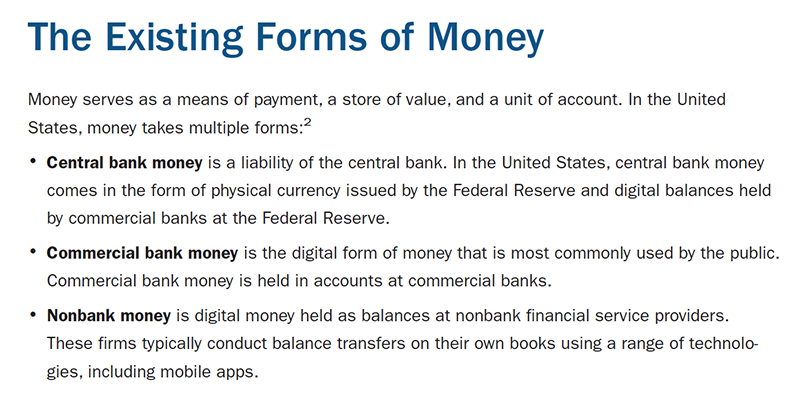
The Federal Reserve published their first public paper on digital dollars, a.k.a. Central Bank Digital Currencies, a.k.a. the dollar CBDC. This, of course, is spurred by the popularity of cryptocurrencies and the questions of whether they will replace the government issued fiat currencies.
At a high level, this paper says nothing interesting. A bone dry nothingburger.
But what is interesting is the strong distinction that the Federal Reserve makes between real dollars, bank dollars, and non-bank dollars.

Most of us don’t make this distinction. In normal times, outside of economic panics, these dollars are all completely interchangeable. I explain this in part one of my lesson in how crypto and blockchain work.
It make sense that the Fed takes great care over this distinction, as from the Fed’s point of view, only it’s dollars are real dollars. The Fed is responsible for keeping the banking system as a whole working, but not any one bank. The bank dollars in any one bank are insured only up to $250,000, and thus from the Fed’s point of view, those dollars are orders of magnitude more risky to citizens, but as the Fed by charter isn’t allowed to have accounts for individual people or non-bank businesses, bank dollars are all we have access to.
All, except for the non-bank dollars, which from the Fed’s point of view are unregulated, uninsured, and incredibly risky. This despite most of those non-bank dollars being in structures like money market mutual funds, which themselves are mostly invested in U.S. Treasuries. Plus some of those non-bank dollars in Paypal accounts or Starbucks gift cards, where there is no chance of a bank run as those dollars are in turn stored in a bank or in treasuries or some other low risk, highly liquid investment.
Anyhow… back to the question of the role of digital dollars. What this paper fails to provide is any compelling reason for them to exist. The Fed describes their CBDC as something far more like Paypal thank crypto. Centralized, non-transparent, completely trackable by authorities. Something like Visa, run not by one central organization but by the existing banks.
Dig into the details and really the Fed is saying nothing more here than that perhaps bank dollars will disappear, replaced by digital dollars all guaranteed by the Fed. Or maybe not all guaranteed, as they also say that it may be that there is a limit on how many CBDCs any one person can own.
All in all, if you are a crypto fan, then there is nothing here that should worry you, as there is nothing here that looks like a FedCoin or Tether or USDC.














